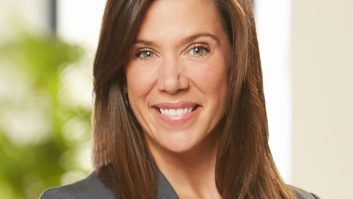NEW YORK –
Best Buy has had one of the worst
months it has ever experienced — reporting a $1.7 billion
fiscal fourth-quarter loss, the announcement of
$800 million in cost cutting for the next three years,
the closing of 50 big-box stores, and, finally, the unexpected
resignation of CEO Brian Dunn and subsequent
investigation into possible personal misconduct.
While Wall Street analysts and the media began
to pick apart Best Buy’s cost-cutting strategy before
the Dunn resignation, it became a feeding frenzy afterwards,
with seemingly anyone who had ever bought
anything at Best Buy weighing in as to its current strategy,
its future and what type of CEO it should turn to
during this time of crisis.
Best Buy is considering internal candidates for the
job — interim CEO Mike Mikan along with Mike Vitelli
executive VP and president of its U.S. operations,
among others. Pundits have suggested
that the pool of candidates
should only be centered on those
with online retailing experience.
TWICE contacted several industry
executives who have worked
with, sold to or competed against
Best Buy for years and asked this simple question: If
you were named CEO of Best Buy, what would you do
to turn its fortunes around?
Here are their views:
Franklin Karp, COO, Audio Video Systems:
I would look at the sales staff. A non-commissioned
floor without any incentives has already
proven to be unsuccessful.
It is no wonder people visit their
stores, snap photos of UPC codes
and shop online. They know they
will not be engaged or asked for
the sale. What motivation does the
current staff have to do anything
but watch for theft and punch the
clock? You will reap what you sow
— a lousy, unexciting retail experience leads to diminished
sales.
Elly Valas, member services director, Nationwide
Marketing Group:
I would
determine a direction and a vision.
[Chairman and founder] Dick
Schulze clearly knew what kind of
store he wanted. His formula won’t
work now. At
this point, Best
Buy is kind of
like Kmart — not
the low price
leader (Walmart) nor the fashion
place (Target).
Best Buy cannot compete well with Amazon on
price or with the low overhead that leads to the low
prices online. I’d reduce store count and size.
There is a real opportunity for service leadership in
the CE space, but blue shirts can’t provide it. Home
networking, smart-home connection, etc., are not really
do-it-yourself projects. Who’s going to connect my
smart refrigerator to the grid once I get my new smart
meter?
and visionary. [The new CEO] must understand technology
and retailing and be able to create and execute
a first-rate customer experience to differentiate Best
Buy in the marketplace. Also, the new CEO must have
the courage and the board support to put re-building
the company ahead of share holder value, stock price
and growth.
Retooling will require thought, new ideas, risk-taking
and vision, someone who can start from the ground
up — with nothing but the great Best Buy logo and
a keen sense of reinvention. The next CEO must be
willing to look back at the company’s history but not be
beholden to it.
Gary Shapiro, president/
CEO, Consumer Electronics
Association:
I’d refocus staff on
service and issue a new consumer
pledge. I’d differentiate, offer installation
[and carry] new installation
products … like health care and
security monitoring, solar and wind
power.
Daniel Pidgeon, chairman,
Starpower:
They need a plan to get customers excited
to visit the stores. If no one wants to go there — or even
worse, actively avoid the store — there is no hope. I always
hear bits and pieces of certain strategies that never
get fully implemented [at Best Buy]. Get some smart
people in a room, define the strategy and don’t deviate
from the plan until you have excited the consumer.
They need a real
estate plan. [Current
stores are] not
“fun.” It’s like visiting
a pharmacy.
They have no competitive
advantage
from Walmart from a
display perspective.
What they need is a
slimmed-down store
format that is open, bright and engaging.
Throw the old plans out and get
serious about a real store experience.
I don’t care if the sales tax issue
gets passed — they will not beat Amazon
at their game. They need an Internet
strategy that engages the client
and motivates them to use the store
for something other than fulfillment.
Clever merchandising
of the site, by
raising questions
about their use of
the selected products,
positions them
as someone that
truly cares. They can get the user to
engage on a higher level and drive
traffic to the stores by making “preselections”
for a site visit where they
“set an appointment” with a rep — who
actually knows what they are doing —
at “a store near you.”
The company needs to go private.
It will cost the equity holder … but it
can be structured with an upside to
shareholders so they retain some equity
position. There are plenty of private
equity firms with sufficient capital
and desire to make this happen. Best
Buy’s moves cannot continue to be
scrutinized by Wall Street, and their
CEO has to get off the front page of
The Wall Street Journal.
Bob Weissburg,
global executive
VP, Gibson Guitar:
I would improve
the training of the
sales staff. This has
to be the biggest
complaint of consumers.
Revamp the
entire blue shirt organization.
Develop
specialist in store,
pay them a living wage, train them to
be knowledgeable about technology,
truthfully answer questions, guide customers
to the right products, and, yes,
even demonstrate the gear for them.
Go to the store. Listen to the customer
but not with news cameras so
the stock holders can see I’m working.
Listen to the employees who actually
care about what the company is
doing. The capable front-line people
probably know what’s wrong but don’t
feel anyone in corporate is interested
in their opinion. Create a store personnel
committee to solicit their input.
I thought back when Best Buy was
really growing and turning the industry
on its ear. What was going on in
the stores? Excitement! Consumers
couldn’t wait to see the latest cool
consumer electronics. Today the
store is boring — walls of TVs just like
Walmart, the home audio department
is a shrinking passive display, the
speaker demos rarely work or no one
in the store is capable of demonstrating
most of the gear. Get new products
in, make a big deal about what’s
going on in the store, have in-store
demo days, get people excited about
products and technology. There is
more new technology today than ever
before but you wouldn’t know it.
Everyone is talking about how physical
stores are a liability,
turn it into
an asset. It can
give you a huge advantage
over Amazon.
Challenge
the merchandising
team to get out of the box and not just
worry about covering their [rear-ends].
Where is the passion about products?
] to this day the
pricing is wrong, the merchandising is
wrong and no one is minding the store.
Use the Internet to get people in
store and use the store for people to
shop online. I really think if they get
highly focused on the web, they can
win and use the stores as a competitive
advantage. If you consider the
revenue capability of the website, why
aren’t they putting huge resources behind
it? Take the costs you are cutting
and reinvest it in dot-com.
Peter Weedfald, president, Gen
One Ventures:
Best Buy’s greatest
defense against a
multitude of sharp
and smart competitors
through
vast declines in CE
manufacturer profitability
and through
hyper-changing
consumer, digital
and social dynamics
is a calculated asset
offense.
Best Buy has a multitude of empirical
strengths and assets: 1,400 store
locations, largest retail emporium for
CE products, multimodal employee
selling talents (stores, dot-com, direct,
etc), Geek Squad support for in home/
business service … a best-of-breed
Rewards Card program and in-store
blue shirt sales support, refulgent
merchandising and marketing teams,
a highly competitive and targeted publishing
infrastructure, and fungible, unyielding
executive team focus.












